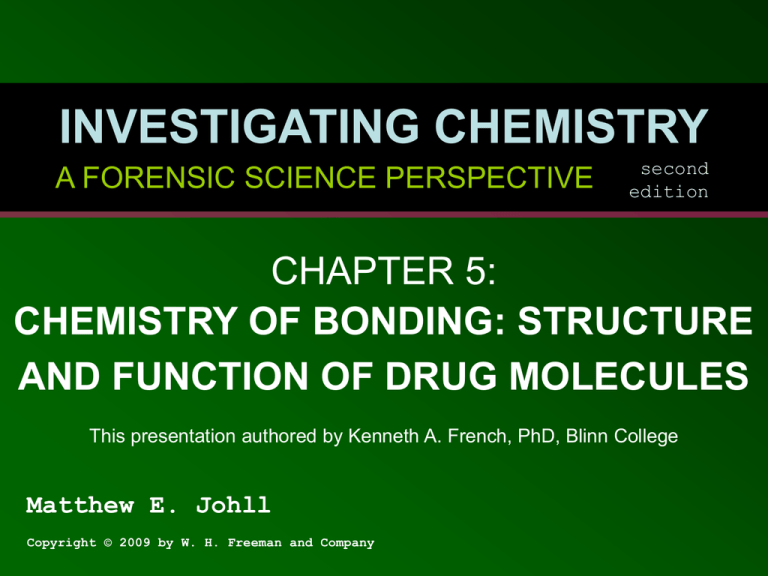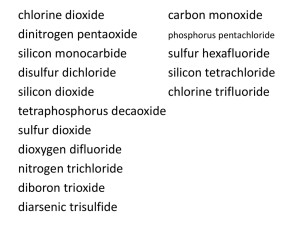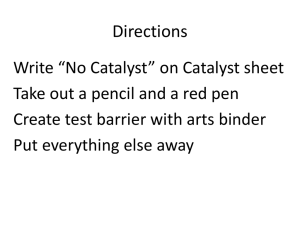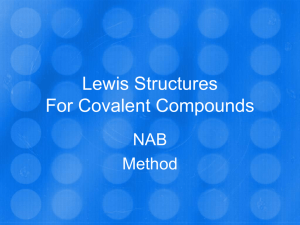Investigating Chemistry - Chemistry at Winthrop University
advertisement

INVESTIGATING CHEMISTRY A FORENSIC SCIENCE PERSPECTIVE second edition CHAPTER 5: CHEMISTRY OF BONDING: STRUCTURE AND FUNCTION OF DRUG MOLECULES This presentation authored by Kenneth A. French, PhD, Blinn College Matthew E. Johll Copyright © 2009 by W. H. Freeman and Company CASE STUDY: NO MOTIVE, NO OPPORTUNITY • A happily married couple suffered the unexpected death of the paraplegic, but otherwise happy and healthy husband. • Three years later the wife was arrested and convicted of the murder of her spouse. • This despite no apparent motive or any flaw in her alibi (no timeline discrepancies). • Immunoassay found excess insulin in his body and she was a nurse with access to it. Chapter 5 Opener, pg. 137 Investigating Chemistry, 2nd Edition © 2009 W.H. Freeman & Company CHEMISTRY OF ADDICTION • 5.1 Nature of Covalent Bonds • 5.2 Lewis Structures of Ionic Compounds • 5.3 Lewis Structures of Covalent Compounds • 5.4 Resonance Structures • 5.5 VSEPR Theory CHEMISTRY OF ADDICTION • • • • 5.6 Polarity of Bonds and Molecules 5.7 Molecular Geometry of Drugs 5.8 Drug Receptors & Brain Chemistry 5.9 Case Study Finale: No Motive, No Opportunity 5.1 NATURE OF COVALENT BONDS • According to the valence bond (VB) theory, a covalent bond is formed between two atoms when their orbitals overlap. • The overlapped orbitals create a region of high electron density (RHED) between the nuclei, and this constitutes the covalent bond, where 1, 2, or 3 pairs of electrons are shared between adjacent atoms in 1, 2, or 3 sets of such orbitals. • Illegal drugs, like prescribed ones, are organic molecules, and as such, they are held together by many covalent bonds. Two H atoms form a molecule of H2 when the nucleus of one attracts the electrons of the other. A single bond contains two electrons that are attracted to both nuclei. The first bond to form is always a sigma bond with its RHED between the two nuclei. Why is that the case? Figure 5.2, pg. 140 Investigating Chemistry, 2nd Edition © 2009 W.H. Freeman & Company IMMUNOASSAY • This analytical technique can measure the concentrations of drugs, hormones, or antibodies in the body. • Based on the unique, 3D shape of the target molecule (drug), a receptor molecule having a suitable cavity can be used to bind to it. • Because cyclodextrin has a cavity suitable for binding to benzene’s aromatic ring, it can be used to detect methamphetamine, which has a structure dominated by a benzene ring. • Question: Aspirin has a benzene ring. Could it interfere with the immunoassay? Benzene (the target) is able to bind to cyclodextrin (the receptor) mainly due to their compatible 3D geometries. Figure 5.1, pg. 139 Investigating Chemistry, 2nd Edition © 2009 W.H. Freeman & Company 5.1 NATURE OF COVALENT BONDS • The VB theory explains bonding in covalent compounds, but is not entirely adequate in predicting shapes of molecules. • The Lewis theory of bonding will enable us to predict the number of bonds formed by each atom, but not the bond angles. • The valence shell electron-pair repulsion (VSEPR) theory will allow us to predict the actual molecular geometries based on the local geometries of individual atoms. COVALENT BONDS • Sigma bonds are formed when two s orbitals overlap, when one s and one p orbital overlap, or when two p orbitals overlap end-to-end. All single bonds are sigma bonds. • Pi bonds are formed when the p orbitals from 2 different atoms overlap side-to-side. A double bond (C=C) has one sigma bond and one pi bond. Triple bonds have one sigma bond and 2 pi bonds. • Question: How many electrons are shared in a quintuple bond? 5.2 LEWIS STRUCTURES OF IONIC COMPOUNDS • The Lewis theory of bonding indicates that each atom, with some exceptions tends to share, gain or lose electrons to achieve the same electron configuration as the nearest noble gas. • Some exceptions: H seeks 2 electrons, Be seeks 4, B & Al seek 6, and elements below C, N, O & F often exceed 8 electrons. • Most elements form bonds by becoming isoelectronic with a noble gas. That is, they gain, lose, or share electrons to achieve the same outer electron configuration as a noble gas (an octet). 5.2 LEWIS STRUCTURES OF IONIC COMPOUNDS • The octet rule states that elements undergo chemical reactions to get 8 electrons in their outermost energy level or valence shell. • The elements C, N, O, and F never exceed 8 electrons, but many elements below them do by using their d-orbitals. N may have 7 or 8. • Counting from 1 to 8 and skipping the transition elements, you can determine the number of valence electrons from the representative elements (s- and p-block). This chart shows in red the number of outermost or valence electrons for 8 families. Also note the Lewis symbols for elements 3-10. Figure 5.3, pg. 142 Investigating Chemistry, 2nd Edition © 2009 W.H. Freeman & Company 5.2 LEWIS STRUCTURES OF IONIC COMPOUNDS • Metals lose electrons to gain the noble gas electron configuration of the previous noble gas. Metals form cations. Na Na1+ + 1e- This same pattern is followed by all the Group 1 metals (Alkali Metals). • Nonmetals share electrons to form molecules or gain electrons to form anions to become isoelectronic with the next noble gas. S + 2e- S2• Note that S, Se, & Te resemble oxygen in that they gain two electrons to form anions. CaO is an ionic compound. It forms when the Ca atom provides 2 electrons to the O atom. The metal atom gets oxidized to the Ca2+ ion. Figure 5.4, pg. 143 Investigating Chemistry, 2nd Edition © 2009 W.H. Freeman & Company 5.2 LEWIS STRUCTURES OF IONIC COMPOUNDS • Single bonds share two electrons between the two atoms. • Double bonds share four electrons (2 pairs). • Triple bonds share six electrons (3 pairs). • The higher the bond order, the shorter and the stronger the bond is. • N2 has a triple bond, which is shorter and stronger than the N=N bond, which is shorter and stronger than the N-N bond. DRAWING LEWIS STRUCTURES OF COVALENT COMPOUNDS AND IONS • 1. Count all the valence electrons for all the atoms. Subtract one electron for each positive charge. Add one electron for each negative charge. • 2. Arrange the atoms with the unique one in the center and connect them to the central atom by one pair of electrons each. Symmetry is a useful guide: O-S-O and not S-O-O. • 3. Complete the octets of all the noncentral atoms (except H). Count the number of electrons used so far and then subtract from the original total. • 4. If there are surplus electrons, place them in pairs on the central atom. These are lone pairs. • If and only if the central atom (other than Be, B or Al) does not have an octet, borrow 1 or more pairs of electrons from one or more noncentral atoms to share with the central atom. • Consider the sulfate ion, SO42-. How many valence e’s are there? EXAMPLE: THE SULFATE ION, SO42• 1. S has 6 valence e’s. So does each O atom. Add two for the -2 charge: • 6 + 4(6) + 2 = 32 valence electrons • 2. Put the four O atoms around the S. • 3. Complete the octet for each O atom. • 4. Do we have any leftover e’s? No! 32 total – (4x8 = 32) used = 0 left • So there are no lone pairs on the central atom, S, but each O has three lone pairs. • 5. There are no multiple bonds to the S atom because it had 8 electrons in the four bonds to four O atoms. These covalent bonds are formed as atoms share electrons to achieve an octet in their outermost or valence shell. Figure 5.5, pg. 143 Investigating Chemistry, 2nd Edition © 2009 W.H. Freeman & Company How many electrons are shared by the two O atoms in the last structure? Please note that the actual O2 molecule has unpaired electrons and a bond order of two. Figure 5.5, pg. 143 Investigating Chemistry, 2nd Edition © 2009 W.H. Freeman & Company EXAMPLE PROBLEM: Are there any errors in these Lewis structures? • :O=S=O: Hint: Count valence electrons first. • Yes. S does have an octet, but not O, and there should be a total of 3 x 6 = 18 valence electrons placed. We see just 12. Each line is 2 electrons. • ? :O=N=O: Note the triple bonds between N & O. • Wrong structure again. This time the O atoms have octets, but the N atom has 12 e’s. We see 16 valence electrons placed, but we need 17. One double bond (O=N) and one single bond (N-O) are needed. The odd electron goes on N. • The odd electron on N represents an exception to the octet rule. Here as in NO, nitric oxide, also, N has 7 electrons. • Question: Does N have just 7 electrons in N2O? Nitrogen dioxide, NO2, tends to dimerize to form dinitrogen tetroxide, N2O4, due to its unpaired electron. • Since the odd electron on N represents a highly reactive species (a free radical), it explains why two NO2 molecules readily form N2O4: • O2N. + .NO2 O2N:NO2 (a stable molecule) • Recall that H. combines with itself to form H2 molecules because the unpaired electron is so reactive. [BrINClHOF are the diatomic elements.] • Can you write the Lewis structure for NO? • Use only 11 valence electrons and :N=O:. • Propose a mnemonic for remembering the diatomic elements. 5.4 RESONANCE STRUCTURES • Benzene, an aromatic hydrocarbon, has two resonance structures (Lewis structures), but the real structure has six identical bonds, not three C=C’s and three C-C, which are longer and weaker than the double bonds. • The realistic structure is called the resonance hybrid and can be described in terms of the resonance structures. • Each C atom has a p orbital with one electron in it. The orbitals overlap side-to-side to form a continuous electron cloud above and below the ring. Neither of these two Lewis structures adequately explains why all the C-C bonds are equal in the actual molecule. When two or more Lewis structures can be drawn, we observe resonance, an enhanced stability. Benzene, C6H6, is best represented by a composite of the two structures below called the resonance hybrid. It is not flipping back and forth between these two structures any more than a mule changes between a horse and donkey. A mule is a biological hybrid. This representation of benzene, C6H6, more accurately shows that all the C-C bonds are alike. For convenience we draw a simple circle inside the hexagon to distinguish benzene from cyclohexane, C6H12. 8.5 VSEPR THEORY • The valence shell electron-pair repulsion theory is based on the idea that both bond pairs and lone pairs of electrons move as far apart as possible around an atom due to their like charges repelling each other. • We need to distinguish between the electronic geometry and the molecular geometry (shape of the molecule). • Question: If the central atom has a lone pair can the two geometries be the same? Why isn’t water a linear molecule? Drawing the Lewis structure shows us that the O atom has 4 RHED’s, two bond pairs of electrons and two lone pairs. That makes the electronic geometry tetrahedral and the molecular geometry bent. Unnumbered Figure, pg. 148 Investigating Chemistry, 2nd Edition © 2009 W.H. Freeman & Company Another way to represent water is to remove two of the H atoms from CH4, methane, and leave the stick bonds to represent lone pairs. Then color the black C atom red to represent O in H2O. Then is it clear why water can’t be a linear molecule, which would render it nonpolar. Unnumbered Figure, pg. 148 Investigating Chemistry, 2nd Edition © 2009 W.H. Freeman & Company Once we determine the correct Lewis structure based on the total number of valence electrons, we can apply the VSEPR theory to predict the electron geometry, and thence the molecular geometry (if different). Figure 5.8, pg. 149 Investigating Chemistry, 2nd Edition © 2009 W.H. Freeman & Company The NH4+ ion, like methane, CH4 , is tetrahedral. The NO3- ion resembles BF3, and is trigonal planar. Ammonium nitrate, NH4NO3 is a fertilizer, but has been used by foreign and domestic terrorists as an explosive. Unnumbered Figure, pg. 149 Investigating Chemistry, 2nd Edition © 2009 W.H. Freeman & Company WHEN MOLECULAR GEOMETRY DIFFERS FROM ELECTRON GEOMETRY • When the central atom has no lone pairs, the two geometries coincide. • CO2, 0=C=O, is linear since the C has no lone pairs. • SO2 is bent since the S has a lone pair giving it three RHED’s, making its electron geometry trigonal planar. Figure 5.9, pg. 150 Investigating Chemistry, 2nd Edition © 2009 W.H. Freeman & Company BF3 has trigonal planar molecular geometry, but SnCl2 is bent. CH4 is tetrahedral, but :NH3 is pyramidal. Figure 5.9, pg. 150 Investigating Chemistry, 2nd Edition © 2009 W.H. Freeman & Company 5.6 POLARITY OF BONDS & MOLECULES • The physical and chemical properties of any molecule are strongly affected by whether it is polar or not. • Having polar bonds depends on there being a difference in electronegativities between the bonded atoms. • The larger the difference, the greater the polarity of the bond. • When there is no difference in electronegatitivites, the bond is nonpolar. Ex: HH, Cl-Cl or even F-F. • When there is an extreme difference (>2.0), the bond is considered “ionic” . KF, NaBr, CsI or LiCl. These nonmetals lie close to F on the periodic table. So they have relatively large electronegativity values. Table 5.1, pg. 152 Investigating Chemistry, 2nd Edition © 2009 W.H. Freeman & Company The C-Cl bond is polar, but due to its high degree of symmetry and the mutual cancellation of effects, CCl4 is nonpolar! Figure 5.10, pg. 153 Investigating Chemistry, 2nd Edition © 2009 W.H. Freeman & Company How can nonpolar molecules have polar covalent bonds? • Ammonia, NH3, is a polar molecule with polar covalent bonds, but BF3 is a nonpolar molecule with even more polar bonds. • Why is this true? • Since BF3 is flat with no lone pairs on the B atom, the three B-F bonds cancel each other’s effects due to symmetry considerations. • With :NH3, that can’t happen. The lone pair on N disrupts the symmetry. Why isn’t NH3 flat just as BH3 is? The Lewis structure shows a lone pair on the N atom. So it has tetrahedral electronic geometry resulting in a trigonal pyramidal molecular geometry. Unnumbered Figure, pg. 154 Investigating Chemistry, 2nd Edition © 2009 W.H. Freeman & Company Question: As the polarity of the molecules increases, what happens to the solubility in water? Table 5.2, pg. 154 Investigating Chemistry, 2nd Edition © 2009 W.H. Freeman & Company 5.7 MOLECULAR GEOMETRY OF DRUGS • The precise shapes of both legal and illegal drug molecules helps explain how they work in the body. • In the body, proteins such as enzymes and antibodies act as a sort of key to another molecule’s lock. • These key-type molecules are so precisely designed that even the mirror image molecule (stereoisomer) will not serve as a lock that binds with them. Stereoisomers have not only the same molecular formula but even the same connectivity (sequence of atoms). The only difference between them is the way the atoms are arranged in space. Only one is physiologically active. Figure 5.11, pg. 155 Investigating Chemistry, 2nd Edition © 2009 W.H. Freeman & Company This common household product contains l-methamphetamine, which has none of the stimulant effects of the d-isomer (mirror image), which is an extremely addictive illegal drug. Unnumbered Figure, pg. 155 Investigating Chemistry, 2nd Edition © 2009 W.H. Freeman & Company Many lives have been broken on these “rocks”. Crystals of d-methamphetamine. The l-isomer (the mirror image) is a useful and ubiquitous medication. Unnumbered Figure, pg. 155 Investigating Chemistry, 2nd Edition © 2009 W.H. Freeman & Company Carbon is gray, oxygen is red, nitrogen is blue. What is white? Figure 5.12, pg. 156 Investigating Chemistry, 2nd Edition © 2009 W.H. Freeman & Company LSD or lysergide, is the N,N-diethylamide made from Dlysergic acid, and is a controlled substance, a dangerous hallucinogen. Can you find these functional groups? The 2o amine, the 3o amine, the amide, the 2 aromatic rings? Figure 5.13, pg. 157 Investigating Chemistry, 2nd Edition © 2009 W.H. Freeman & Company The scientist employs virtual reality to wrestle with a protein (ribbon) while grasping a segment of DNA (in blue). Figure 5.13, pg. 157 Investigating Chemistry, 2nd Edition © 2009 W.H. Freeman & Company The shape of any molecule, such as this LSD, depends on the local geometries for each of its atoms. Rotated ball-and-stick models are shown. 5.8 DRUG RECEPTORS & BRAIN CHEMISTRY • Certain drugs compete very successfully with the body’s neuro- transmitters in the pleasuresensing region of the brain. • Thus they are able to block the uptake of the normal neurotransmitter molecules and produce an artificial state of euphoria as the body tries to compensate by flooding the gap between the neurons with excess neurotransmitter molecules. A scanning electron microscope (SEM) image of a (red) neuron or nerve cell, composed of an axon and one or more dendrites. Unnumbered Figure, pg. 158 Investigating Chemistry, 2nd Edition © 2009 W.H. Freeman & Company HOW A SYNAPSE WORKS Figure 5.15, pg. 159 Investigating Chemistry, 2nd Edition © 2009 W.H. Freeman & Company The blue neurotransmitters carry an electrical signal called an action potential from one neuron to the next. Cocaine (yellow) blocks the signal causing amplification which results in damage. Figure 5.15, pg. 159 Investigating Chemistry, 2nd Edition © 2009 W.H. Freeman & Company Because of its precise size, shape, and polarity, the cocaine molecule is able to very effectively block the normal uptake of neurotransmitters. Figure 5.15, pg. 159 Investigating Chemistry, 2nd Edition © 2009 W.H. Freeman & Company In radioimmunoassay (RIA), a known amount of radioactively labeled drug is allowed to compete with drugs from an evidence sample. The stronger the signal from the radioactive drug, the lower the amount of drug in the evidence sample. Figure 5.16, pg. 160 Investigating Chemistry, 2nd Edition © 2009 W.H. Freeman & Company Just as the human body generates antibodies (large protein molecule, “lock”) to combat antigens (yellow, “key”) by binding specifically to them, immunoassay tests allows the binding of a specific drug like LSD. Unnumbered Figure, pg. 160 Investigating Chemistry, 2nd Edition © 2009 W.H. Freeman & Company 5.9 CASE STUDY FINALE: NO MOTIVE, NO OPPORTUNITY • The prosecution decided to focus on the results of the immunoassay test that indicated Nic Winzar had an unnaturally high level of insulin in his blood. • Experts testified that the insulin levels could only come from someone being injected with insulin. • Despite ample testimony, the hard evidence was not available because the witnesses and informants delayed reporting Dee Winzar’s plot. • Immunoassay tests are not sufficient evidence to • secure a conviction due to the possibility of Unnumbered Figure, pg. 161 Investigating Chemistry, 2nd Edition © 2009 W.H. Freeman & Company 5.9 CASE STUDY FINALE: NO MOTIVE, NO OPPORTUNITY • The usefulness of immunoassay tests is that they assist the forensic chemist in choosing the best methods to provide positive proof of the presence of an illegal drug. • Dee Winzar is in prison today awaiting an appeal and hopes to once again establish her innocence in the death of her husband. • Parole is an unlikely option for Dee as it requires admission of guilt along with remorse. • Would you admit to a crime you did not commit?







